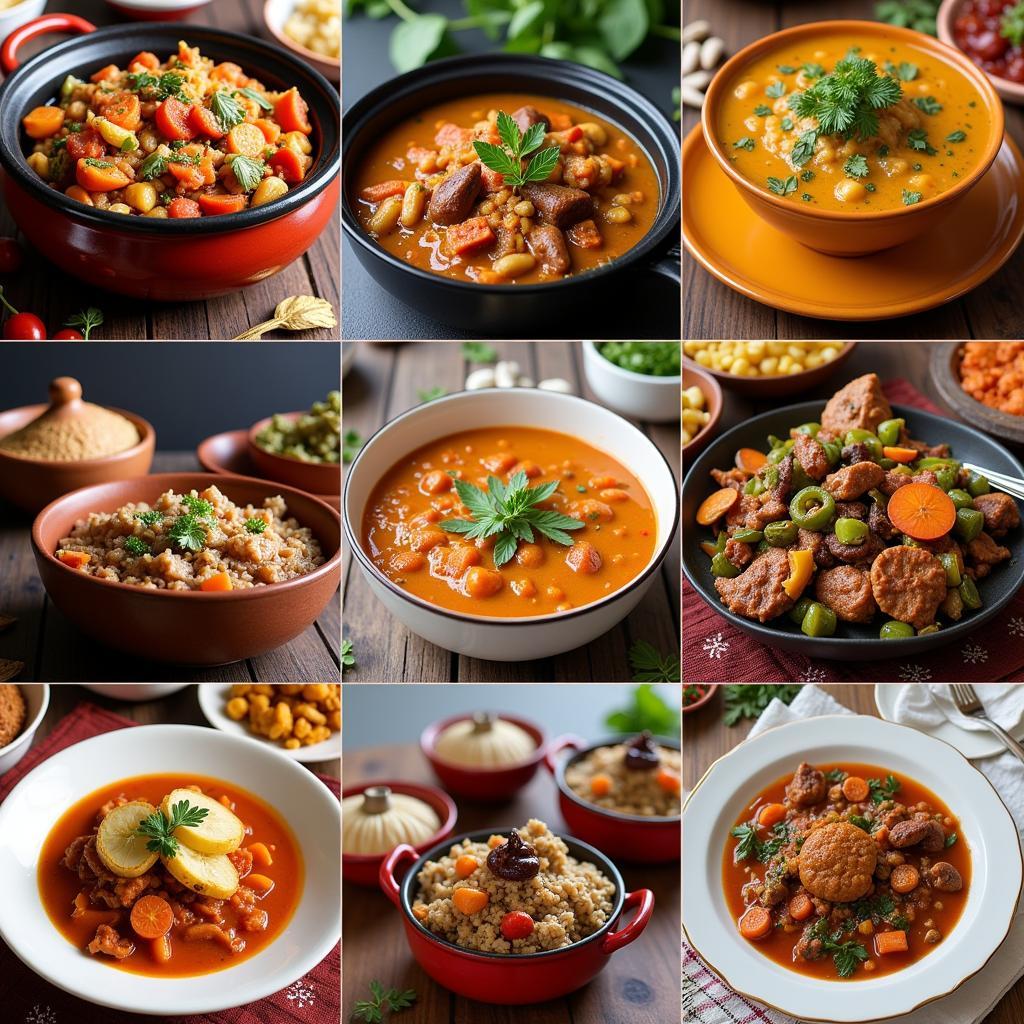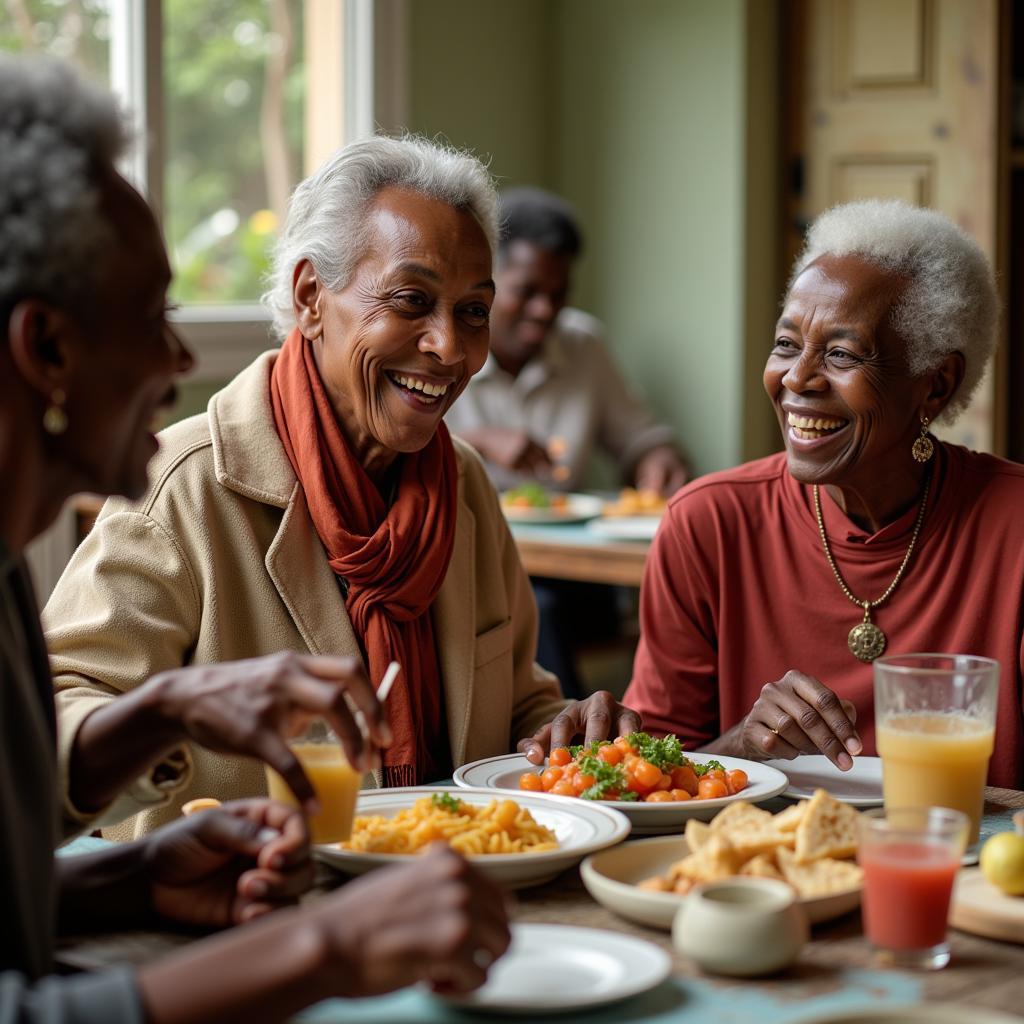Exploring the Rich Tradition of African Hot Pot
The concept of “African Hot Pot” can be interpreted in various ways, reflecting the continent’s diverse culinary landscape. Rather than a single, definitive dish, it speaks to a tradition of communal cooking and shared meals, often featuring simmering pots of flavorful stews, soups, and porridges. These dishes, unique to each region and culture, highlight the ingenuity of African cooks and their resourceful use of local ingredients.
The Heart of African Cuisine: Communal Cooking and Sharing
Across Africa, food is more than sustenance; it’s a celebration of culture, community, and connection. The act of preparing and sharing a meal is deeply ingrained in the social fabric. Many traditional cooking methods, like the use of three-stone fires or earth ovens, naturally lend themselves to larger pots and communal dining.
 African family enjoying a meal together
African family enjoying a meal together
This tradition of communal cooking is beautifully exemplified in dishes that could be considered “African hot pot.” These aren’t necessarily cooked in the same style as East Asian hot pots, but they share the spirit of bringing people together around a single, simmering pot of delicious food.
A Taste of Diversity: Regional Variations of “African Hot Pot”
From the Maghreb to Southern Africa, each region boasts its own unique interpretation of “African hot pot.” Let’s delve into some examples:
- West Africa: Rich, peanut-based stews like Mafé (Senegal, Gambia) and Groundnut Stew (Nigeria, Ghana) are staples, often featuring chicken, beef, fish, or vegetables.
- East Africa: Injera (a spongy flatbread) often accompanies flavorful stews like Wat (Ethiopia) and Sukuma Wiki (Kenya), featuring a medley of vegetables and spices.
- Southern Africa: Potjiekos, a slow-cooked stew traditionally prepared in a three-legged pot over an open fire, is a beloved South African tradition.
- North Africa: Tagines, named after the distinctive conical cooking vessels, are slow-cooked stews combining meat, vegetables, and aromatic spices like cumin, coriander, and saffron.
 Variety of African stews and soups
Variety of African stews and soups
These are just a few examples of the incredible diversity of “African hot pot” traditions across the continent. Each dish tells a story of cultural heritage, culinary creativity, and the deep connection between food and community in Africa.
Beyond the Pot: The Significance of Shared Meals in African Culture
In many African cultures, mealtimes are more than just about eating; they are opportunities for strengthening bonds, sharing stories, and passing down traditions.
- Respect for Elders: Often, the eldest person at the table is served first, reflecting the respect for seniority prevalent in many African societies.
- Hospitality and Generosity: Guests are always welcomed with warmth and generosity, often offered the most prized cuts of meat or the best portions of the meal.
- Storytelling and Wisdom: Mealtimes are often when stories are shared, lessons are imparted, and wisdom is passed down through generations.
 Elders sharing stories and laughter during a meal
Elders sharing stories and laughter during a meal
The “African hot pot,” in its many forms, embodies this spirit of togetherness. It represents the essence of African hospitality, the richness of its culinary heritage, and the profound connection between food, culture, and community.
Conclusion: Experience the Warmth of African Hospitality
“African hot pot” may not be a singular dish, but it’s a powerful symbol of the continent’s culinary soul. It reflects the warmth, generosity, and deep sense of community that permeates African culture. So, the next time you have the opportunity to enjoy an African stew or soup, remember that you’re tasting more than just food – you’re experiencing the heart and soul of Africa.
FAQ
1. What is the most popular type of “African hot pot”?
Due to the vastness and diversity of the African continent, there isn’t one definitive “most popular” type of African hot pot. Each region has its specialties. However, dishes like Mafé, Wat, and Potjiekos are all incredibly popular within their respective regions.
2. Are “African hot pots” spicy?
The level of spice in “African hot pots” varies greatly depending on the region and specific recipe. Some stews, like certain types of Wat, can be quite spicy, while others rely on more subtle flavor combinations.
3. What are some common ingredients in “African hot pots”?
Common ingredients include tomatoes, onions, garlic, ginger, chilies, peanuts, leafy greens, root vegetables, and various spices. Meat, fish, or poultry are often included, but there are also many delicious vegetarian options.
4. Where can I find authentic “African hot pot” recipes?
There are numerous online resources and cookbooks dedicated to African cuisine. Look for recipes from specific regions or countries that interest you. For a truly immersive experience, consider joining a cooking class or seeking out an authentic African restaurant.
Looking for More?
- Discover the perfect African island holiday hotspot for your next getaway!
- Learn about the captivating world of African adoption photolisting and the stories they tell.
Need assistance planning your African adventure or seeking more information on African culture? Contact us at +255768904061, email us at kaka.mag@gmail.com, or visit our office in Mbarali DC Mawindi, Kangaga, Tanzania. Our dedicated team is available 24/7 to help.